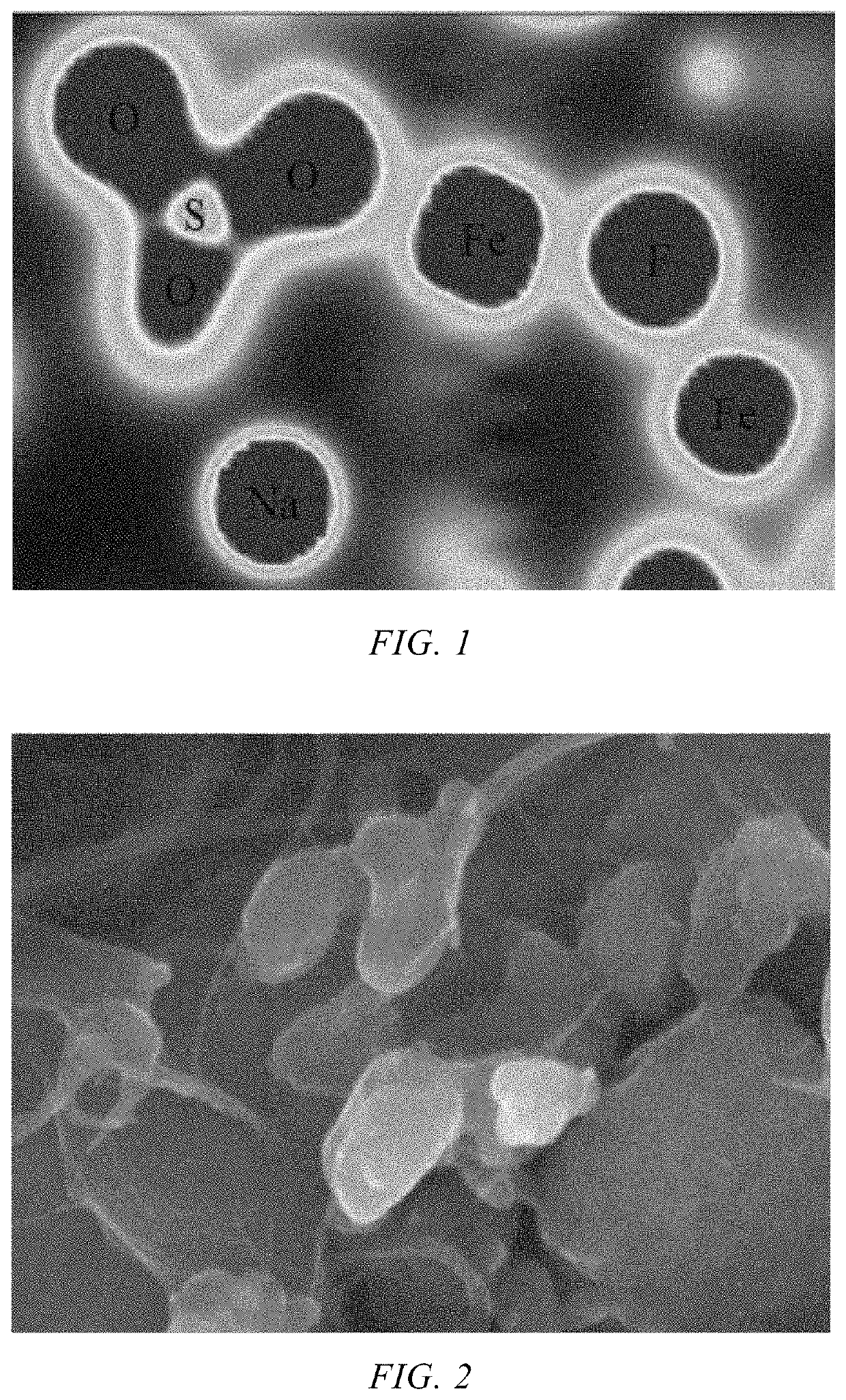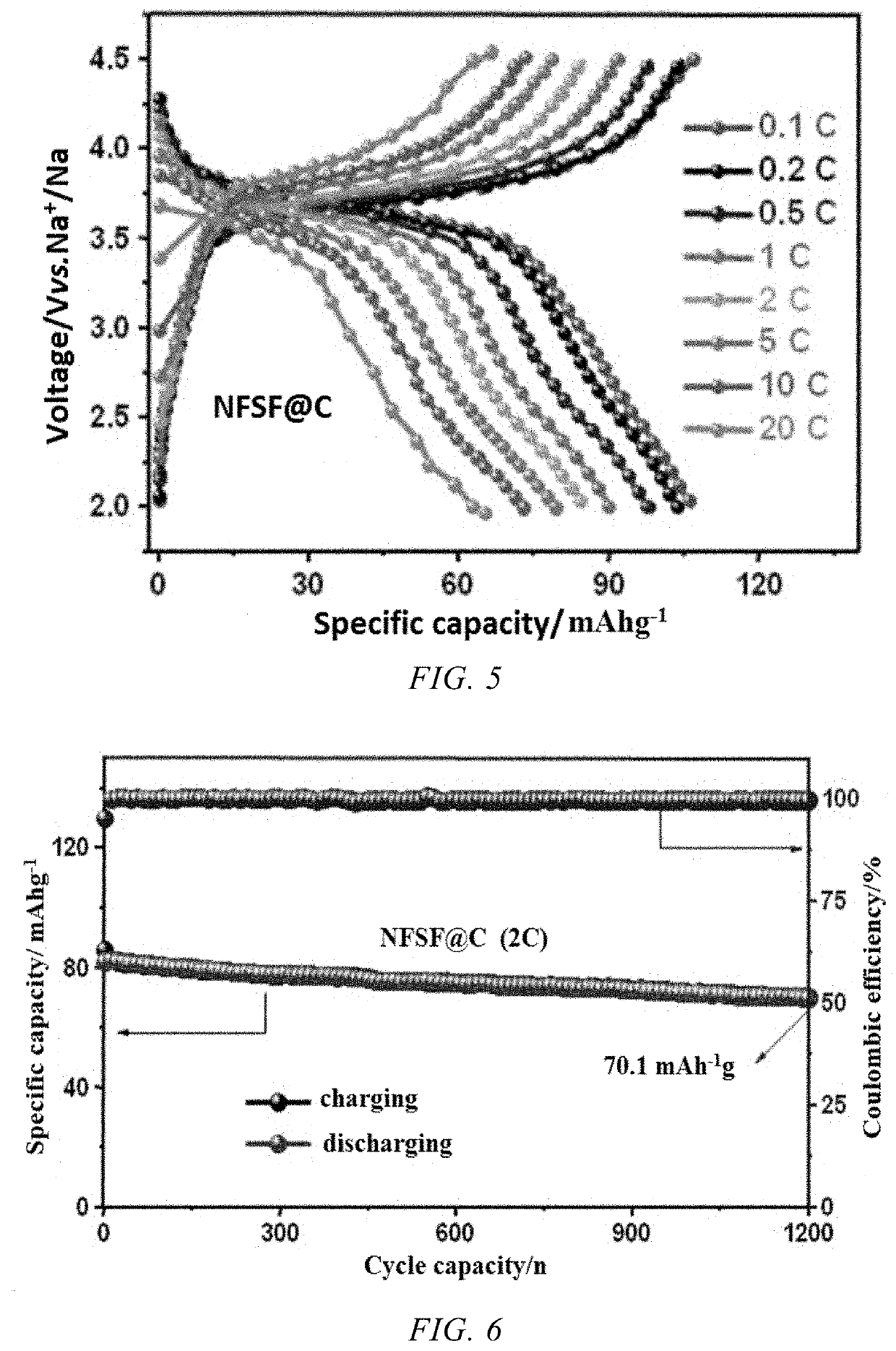Iron-based cathode material for sodium-ion battery, preparation method thereof, and corresponding sodium-ion full battery
- Summary
- Abstract
- Description
- Claims
- Application Information
AI Technical Summary
Benefits of technology
Problems solved by technology
Method used
Image
Examples
example 1
Preparation of Na3Fe2(SO4)3F / CNF Cathode Material for Sodium-Ion Battery
[0047]1. Ferrous sulfate heptahydrate was dried in an oven at 200° C. for 10 h to obtain anhydrous ferrous sulfate.
[0048]2. 0.4675 g of sodium sulfate, 1.00 g of anhydrous ferrous sulfate, 0.1379 g of sodium fluoride and 0.0803 g of (5 wt%) carbon fibers were weighed, and added to a 50 mL zirconia jar. 34 g of zirconia balls was added, and the ball-to-material ratio was set to 20:1. Argon was fed for protection, and the material was ball milled at a rotation speed of 200 r / min and a revolution speed of 500 r / min for 6 h.
[0049]3. The resulting ball-milled composite precursor was transferred to a tube furnace, thermally treated under an argon atmosphere, and calcinated at 350° C. for 5 h. The calcined product was ground into powder to obtain a composite material containing 5% carbon fibers, which was designated as Na3Fe2(SO4)3F / CNF-5% cathode material.
[0050]FIG. 1 shows the electron cloud distribution of the Na3Fe...
example 2
Preparation of Sodium-Ion Button Battery
[0053]0.8 g of the Na3Fe2(SO4)3F / CNF-5% cathode material, 0.1 g of a conductive carbon material (acetylene black), and 0.1 g of a binder (polyvinylidene fluoride) were weighed at a weight ratio of 8:1:1, and uniformly dispersed in N-methyl pyrrolidone as a solvent. The resulting mixed slurry was evenly coated on an aluminum foil, and dried under vacuum at 120° C. for 10 h to obtain a cathode plate. A thin metal sodium sheet was used as the counter electrode, and the cathode plate, a separator, the counter electrode, a spacer, and a spring were placed in sequence in a CR2032-type coin cell, and a electrolyte comprising sodium perchlorate as the solute at a concentration of 1 mol / L and propylene carbonate as the solvent was added, and then sealed to obtain a sodium-ion button battery.
[0054]FIGS. 4-6 show the electrochemical performance of the coin cell cycled in a voltage range of 2.0-4.5 V vs. Na+ / Na. FIG. 4 shows charge / discharge curves in dif...
example 3
Preparation of a Sodium-Ion Full Battery
[0058]1. 0.8 g of the Na3Fe2(SO4)3F / CNF-5% cathode material, 0.1 g of acetylene black as a conductive carbon material, and 0.1 g of polyvinylidene fluoride as a binder were weighed at a weight ratio of 8:1:1, and dispersed in N-methyl pyrrolidone as a solvent. The uniformly mixed slurry was evenly coated on an aluminum foil, and dried under vacuum at 120° C. for 12 h to obtain a cathode plate.
[0059]2. 0.7 g of hard carbon anode material, 0.2 g of acetylene black as a conductive carbon material, and 0.1 g of polyvinylidene fluoride as a binder were weighed at a weight ratio of 7:2:1, and dispersed in N-methyl pyrrolidone as a solvent. The uniformly mixed slurry was evenly coated on a copper foil, and dried under vacuum at 120° C. for 12 h to obtain an anode plate.
[0060]3. The cathode plate, a separator, the anode plate, a spacer and a spring were placed in sequence in a CR2032-type coin cell. A electrolyte comprising sodium perchlorate as the s...
PUM
 Login to View More
Login to View More Abstract
Description
Claims
Application Information
 Login to View More
Login to View More - R&D
- Intellectual Property
- Life Sciences
- Materials
- Tech Scout
- Unparalleled Data Quality
- Higher Quality Content
- 60% Fewer Hallucinations
Browse by: Latest US Patents, China's latest patents, Technical Efficacy Thesaurus, Application Domain, Technology Topic, Popular Technical Reports.
© 2025 PatSnap. All rights reserved.Legal|Privacy policy|Modern Slavery Act Transparency Statement|Sitemap|About US| Contact US: help@patsnap.com



